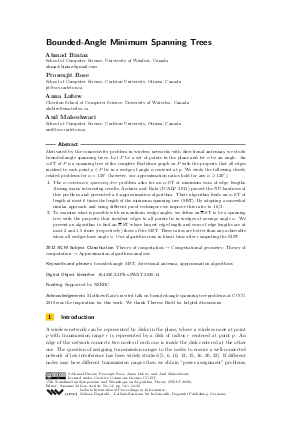@InProceedings{biniaz_et_al:LIPIcs.SWAT.2020.14,
author = {Biniaz, Ahmad and Bose, Prosenjit and Lubiw, Anna and Maheshwari, Anil},
title = {{Bounded-Angle Minimum Spanning Trees}},
booktitle = {17th Scandinavian Symposium and Workshops on Algorithm Theory (SWAT 2020)},
pages = {14:1--14:22},
series = {Leibniz International Proceedings in Informatics (LIPIcs)},
ISBN = {978-3-95977-150-4},
ISSN = {1868-8969},
year = {2020},
volume = {162},
editor = {Albers, Susanne},
publisher = {Schloss Dagstuhl -- Leibniz-Zentrum f{\"u}r Informatik},
address = {Dagstuhl, Germany},
URL = {https://drops.dagstuhl.de/entities/document/10.4230/LIPIcs.SWAT.2020.14},
URN = {urn:nbn:de:0030-drops-122616},
doi = {10.4230/LIPIcs.SWAT.2020.14},
annote = {Keywords: bounded-angle MST, directional antenna, approximation algorithms}
}

 Creative Commons Attribution 3.0 Unported license
Creative Commons Attribution 3.0 Unported license


























